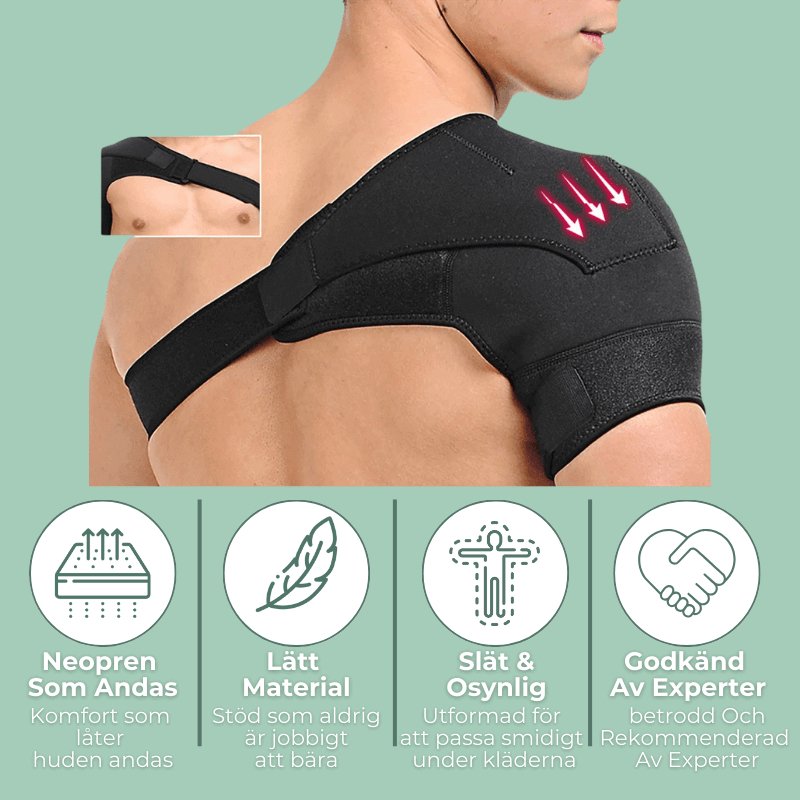Shoulder Injury: Symptoms, Causes, and Treatment

Shoulder injuries are common and can occur in a variety of ways, from sporting activities to everyday accidents. This article reviews the most common symptoms, causes, and treatment options for shoulder injuries.
What are Shoulder Injuries?
Shoulder injuries are injuries to the shoulder joint, muscles and ligaments, often caused by trauma or overuse. They cause pain, stiffness and reduced mobility. Proper diagnosis and treatment with rest, physiotherapy or medication are crucial.
The shoulder is a complex part of the body where several different structures can be injured. Common shoulder injuries include rotator cuff tears, dislocations, joint instability, labral tears, and impingement syndrome. Frozen shoulder can develop after an initial injury and is characterized by pain and severely reduced mobility in the joint capsule. Inflammation of the bursa (bursitis) is a particularly common cause of shoulder pain, see more about bursitis in the shoulder .
Symptoms of shoulder injury
Common symptoms include:
- Pain in the shoulder, especially with movement
- Swelling and tenderness
- Limited mobility in the shoulder joint
- Weakness in the arm
- Feeling of instability in the shoulder
- Numbness or tingling in the arm
Shoulder pain that worsens with certain movements, especially when the arm is raised above head height, is typical of shoulder injuries. In acute injuries, swelling may occur around the shoulder and shoulder blade. Many people experience a sensation that the shoulder is "jumping out of joint" with certain movements, which indicates instability in the joint.
Causes of shoulder injury
Shoulder injuries can occur in several ways:
- Fall on outstretched arm
- Overload during exercise (e.g. bench press)
- Contact sports such as hockey and handball
- Repetitive movements in the gym
- Sudden, forceful movements
Shoulder injuries after falls are particularly common, especially when landing with the arm extended. Injuries related to bench pressing are a common cause of shoulder injuries in active people, often due to incorrect technique or too heavy a load. Damage to the tendons and muscles of the rotator cuff can occur gradually through overload or suddenly through trauma to the upper arm.
Diagnosis and treatment of shoulder injury
Discover products- Rest and relief
- Physiotherapy
- Pain relief
- Surgery
- Reduce the load on the shoulder
- Exercises to regain strength and mobility
- Anti-inflammatory medications if needed
- In case of serious injuries
- Provides support and relief
- Supports during rehabilitation
- May reduce the need for medication
- Supports post-operative recovery

How Shoulder Comfort™ can help with shoulder injuries
Shoulder Comfort™ offers several benefits for people with shoulder injuries:
- Provides support and stability to the injured shoulder
- Helps reduce pain and inflammation
- Improves posture and reduces the risk of incorrect loading
- Can be used during rehabilitation to support the healing process
- Contributes to faster recovery and reduced risk of relapse
In the case of a shoulder injury following a fall, AxelKomforten™ can provide important support during the healing process by relieving the strain on the damaged structure. For people who have suffered a shoulder injury in connection with training, the product can be used as support during rehabilitation exercises. AxelKomforten™ helps stabilize the shoulder during daily activities and can thus accelerate recovery.
Buy nowConclusion
Shoulder injuries can be painful and limiting, but with the right treatment and support, most people can recover well. By combining professional care, rehabilitation, and the use of supportive devices such as the ShoulderComfort™, many people can effectively manage their symptoms and return to normal activity. It is important to follow the rehabilitation program carefully and gradually increase the load on the shoulder to avoid relapse.
For people who have suffered a shoulder injury in connection with an accident, there may be a possibility of compensation from insurance companies. Shoulder injury compensation from, for example, Folksam may be available depending on how the injury occurred. Read more about what rights you have and what documentation is needed to prove your injury.
Frequently Asked Questions (FAQ)
How long does it take to heal a shoulder injury?
Daily inspection is recommended to detect any problems early. Use a mirror to see the underside of your feet or ask someone else for help if you have difficulty seeing properly. Healing time varies depending on the severity of the injury, but can take from a few weeks to several months.
Can I exercise with a shoulder injury?
Light exercise and specific rehabilitation exercises are often recommended. Consult a physical therapist for a customized program.
How do I prevent shoulder injuries during training?
Use proper technique, warm up properly and increase the load gradually. AxelKomforten™ can provide extra support during training.
When should I seek medical attention for a shoulder injury?
Seek medical attention if the pain is intense, persistent, or if you experience significant limitation in mobility that does not improve with rest.
Can AxelKomforten™ be used for all types of shoulder injuries?
ShoulderComfort™ can be helpful for many types of shoulder injuries, but always consult a doctor or physical therapist for personal recommendations.

